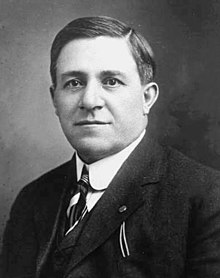Benigno C. Hernández
Benigno Cárdenas Hernández (born February 13, 1862 in Taos , New Mexico , † October 18, 1954 in Los Angeles , California ) was an American politician . Between 1915 and 1917 and from 1919 to 1921 he represented the first constituency of the state of New Mexico in the US House of Representatives .
Early years and advancement
Benigno Hernández attended both public and private schools in his homeland. Between 1880 and 1889 he was a clerk in a general store in Taos County . He also dealt with livestock. In 1896 he moved to Lumberton , Rio Arriba County , where he worked in commerce. Between 1900 and 1904 he was a notary in this district. There he also served as a judge at a probate court. From 1904 to 1906 he was sheriff's chief of police in Rio Arriba County. Between 1908 and 1912, Hernández was treasurer and tax collector in this district.
Political career
Benigno Hernández was a member of the Republican Party . He was a delegate at many regional party conventions in New Mexico and at the Republican National Conventions in 1912 and 1916. In 1914 he was elected as his party's candidate for the US House of Representatives, where on March 4, 1915 he was Harvey Butler Fergusson of the Replaced Democratic Party . After an attempted re-election had failed in 1916, he was only able to complete one legislative period in Congress until March 3, 1917 . His seat went to his rival candidate William Bell Walton .
After he had won the congressional elections in 1918, Hernández was able to complete another legislative period in the House of Representatives between March 4, 1919 and March 3, 1921. In Congress, he was a member of the Indian Committee, the Agriculture Committee, and the State Property Management Committee. In 1920, Hernández declined to run again.
Another résumé
In 1921, President Warren G. Harding made Hernández head of the federal tax department in New Mexico. He held this office until 1933. Between 1940 and 1947 he was a member of the New Mexico Selective Service Boards . After that, he retired. He moved to Los Angeles, where he died in 1954.
Web links
- Benigno C. Hernández in the Biographical Directory of the United States Congress (English)
- Benigno C. Hernández in the database of Find a Grave (English)
| personal data | |
|---|---|
| SURNAME | Hernández, Benigno C. |
| ALTERNATIVE NAMES | Hernández, Benigno Cárdenas (full name) |
| BRIEF DESCRIPTION | American politician |
| DATE OF BIRTH | February 13, 1862 |
| PLACE OF BIRTH | Taos , New Mexico |
| DATE OF DEATH | October 18, 1954 |
| Place of death | Los Angeles , California |

